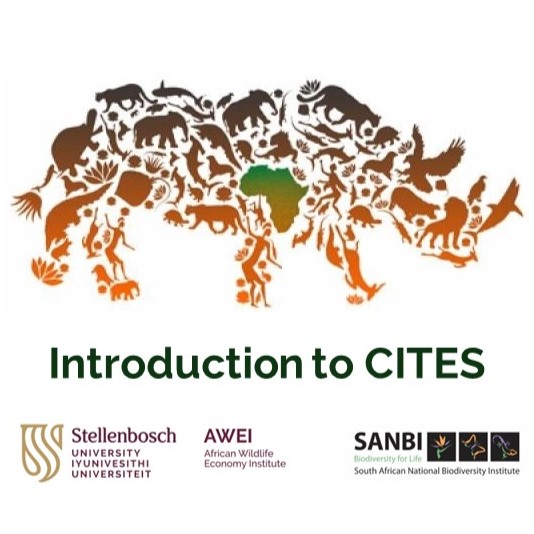CITES Module 1
 1 International biodiversity-related agreements
1 International biodiversity-related agreements
In this module you will learn about some of the key international biodiversity agreements and strategies relevant to the trade in wild species.
Lecture
- Click on the image below to stream the lecture on OneDrive (18 min)
- You can also download the lecture for listening offline
- Take notes while listening
 A selection of key biodiversity agreements and strategies
A selection of key biodiversity agreements and strategies
There are many international biodiversity agreements and strategies that are pertinent to relevant to the trade in wild species. Though the lecture highlighted the four in bold below, you should also familiarise yourself with the others in this list.
1969 - African Convention on the Conservation of Nature and Natural Resources
1975 - Convention on International Trade in Endangered Species of Wild Fauna and Flora (CITES)
1975 - Convention on Wetlands (Ramsar)
1975 - World Heritage Convention (WHC)
1979 - Convention on the Conservation of Migratory Species of Wild Animals (CMS)
1980 – World Conservation Strategy (from IUCN et al)
1991 – Caring for the Earth (from IUCN et al)
1993 - Convention on Biological Diversity (CBD)
1994 - United Nations Convention to Combat Desertification (UNCCD)
1994 - United Nations Framework Convention on Climate Change (UNFCCC)
2015 - Sustainable Development Goals (UN 2030 Agenda for Sustainable Development)
2022 - Kunming-Montreal Global Biodiversity Framework (GBF)
Learning resources - videos
- While watching these videos, reflect on the learning questions provided
- Take notes while viewing
COP15: Kunming-Montreal Global Biodiversity Framework
- On December 19, 2022, the 15th Conference of Parties (COP15) to the UN Convention on Biological Diversity (CBD) adopted the Kunming-Montreal Global Biodiversity Framework (GBF). It has 23 targets that the world needs to achieve by 2030.
(Also being branded as The Biodiversity Plan) - Q: As an internationally agreed framework, how might the GBF be implemented at the national level?
A sustainable future for wild species: 5 takeaways from the IPBES report
- A recently released summary of an assessment from the Intergovernmental Science-Policy Platform on Biodiversity and Ecosystem Services (IPBES) reveals that people rely on 50,000 wild species of plants, animals, algae and fungi.
- Q: Can you think of examples of wild species that are people rely on?
From agreement to action: Moving to the KMGBF implementation!
- Discover the four long-term goals for 2050 and the 23 targets for 2030 of the GBF
- Q: What Goals and Targets are particularly relevant to the trade in wild species?
 Learning resources - readings
Learning resources - readings
- While skimming through these documents, reflect on the learning questions provided
- Also, download documents for future reference
1969 - African Convention on the Conservation of Nature and Natural Resources
- FULLY CONSCIOUS of the ever-growing importance of natural resources from an economic, nutritional, scientific, educational, cultural and aesthetic point of view...
- Q: What does the African Convention say about the sustainable use of wild species?
1975 - Convention on International Trade in Endangered Species of Wild Fauna and Flora (CITES)
- Conscious of the ever-growing value of wild fauna and flora from aesthetic, scientific, cultural, recreational and economic points of view...
- Q: Can you find a definition of wild, conservation, or sustainable use in the convention?
1980 – World Conservation Strategy
- The World Conservation Strategy is intended to stimulate a more focussed approach to the management of living resources and to provide policy guidance on how this can be carried out...
- Q: What does the Strategy say about sustainable use of wild species for local people and for industry?
1993 - Convention on Biological Diversity (CBD)
- Determined to conserve and sustainably use biological diversity for the benefit of present and future generations...
- Q: Does the CBD say anything about the trade in wild species?
2015 - Transforming our world: The 2030 Agenda for Sustainable Development
- We envisage a world in which every country enjoys sustained, inclusive and sustainable economic growth and decent work for all. A world in which consumption and production patterns and use of all natural resources – from air to land, from rivers, lakes and aquifers to oceans and seas - are sustainable...
- Q: What does the 2030 Agenda say about sustainable use and trade of wild species?
2022 - Kunming-Montreal Global Biodiversity Framework (GBF)
- The vision of the Kunming-Montreal Global Biodiversity Framework is a world of living in harmony with nature where “by 2050, biodiversity is valued, conserved, restored and wisely used, maintaining ecosystem services, sustaining a healthy planet and delivering benefits essential for all people.”
- Q: The GBF calls for sustainable and legal trade in wild species in Target 5, but is trade relevant to other targets as well?
 Learning resources - websites
Learning resources - websites
- While browsing these websites, reflect on the learning questions provided
- Also, bookmark websites for future reference
- CITES aims to ensure that international trade in specimens of wild animals and plants does not threaten the survival of the species.
- Q: Are there any countries which are not a Party to CITES?
- The Convention on Biological Diversity was inspired by the world community's growing commitment to sustainable development.
- Q: Why is the CBD a development agreement as much as it is a conservation agreement?
- This historic Framework, which supports the achievement of the Sustainable Development Goals and builds on the Convention’s previous Strategic Plans, sets out an ambitious pathway to reach the global vision of a world living in harmony with nature by 2050.
- Q: What is the guidance to implementing Targets 5 and 9 and how might this relate to CITES?
Biodiversity-related Conventions
- Biodiversity-related conventions work to implement actions at the national, regional and international level in order to reach shared goals of conservation and sustainable use.
- Q: Though CITES focuses on international trade in wild species, is trade an issue in any of the other conventions?
Resumed 18th session of the African Ministerial Conference on the Environment
- Ministers will discuss how to make the African Ministerial Conference on the Environment, the key environmental ministerial forum in the region, stronger and more effective as the region is facing tremendous environmental challenges including climate change, loss of biodiversity and pollution.
- Q: Could this Conference be the platform for aligning African positionson the trade in wild species? If not, is there another forum that could be used?
IISD Earth Negotiations Bulletin Biodiversity Events
- An excellent website for key international events on biodiversity
- Q: Are there any recent events relevant to the trade in wild species?
Let's continueGo to Module 2 International trade-related agreementsGo back to the introduction |
Get updates by email
Through impactful research, stakeholder engagement, and professional development, AWEI is supporting the wildlife economy across Africa. Please subscribe for occasional updates on our work and forthcoming events.
Sign up for a quarterly dose of AWEI insights
In a complex and changing world, AWEI generates strategic ideas, conducts independent analysis on wildlife economies, and collaborates with global scholar-practitioners to provide training and expertise for biodiversity conservation, climate resilience, and inclusive economic opportunities in Africa.
